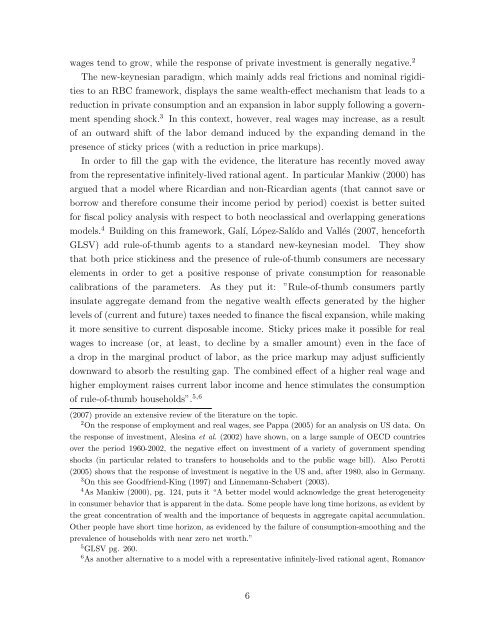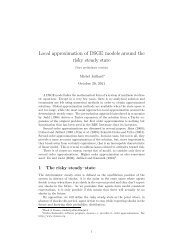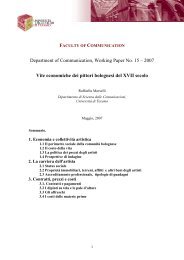The general equilibrium effects of fiscal policy
The general equilibrium effects of fiscal policy
The general equilibrium effects of fiscal policy
Create successful ePaper yourself
Turn your PDF publications into a flip-book with our unique Google optimized e-Paper software.
wages tend to grow, while the response <strong>of</strong> private investment is <strong>general</strong>ly negative. 2<strong>The</strong> new-keynesian paradigm, which mainly adds real frictions and nominal rigiditiesto an RBC framework, displays the same wealth-effect mechanism that leads to areduction in private consumption and an expansion in labor supply following a governmentspending shock. 3In this context, however, real wages may increase, as a result<strong>of</strong> an outward shift <strong>of</strong> the labor demand induced by the expanding demand in thepresence <strong>of</strong> sticky prices (with a reduction in price markups).In order to fill the gap with the evidence, the literature has recently moved awayfrom the representative infinitely-lived rational agent. In particular Mankiw (2000) hasargued that a model where Ricardian and non-Ricardian agents (that cannot save orborrow and therefore consume their income period by period) coexist is better suitedfor <strong>fiscal</strong> <strong>policy</strong> analysis with respect to both neoclassical and overlapping generationsmodels. 4 Building on this framework, Galí, López-Salído and Vallés (2007, henceforthGLSV) add rule-<strong>of</strong>-thumb agents to a standard new-keynesian model.<strong>The</strong>y showthat both price stickiness and the presence <strong>of</strong> rule-<strong>of</strong>-thumb consumers are necessaryelements in order to get a positive response <strong>of</strong> private consumption for reasonablecalibrations <strong>of</strong> the parameters. As they put it: ”Rule-<strong>of</strong>-thumb consumers partlyinsulate aggregate demand from the negative wealth <strong>effects</strong> generated by the higherlevels <strong>of</strong> (current and future) taxes needed to finance the <strong>fiscal</strong> expansion, while makingit more sensitive to current disposable income. Sticky prices make it possible for realwages to increase (or, at least, to decline by a smaller amount) even in the face <strong>of</strong>a drop in the marginal product <strong>of</strong> labor, as the price markup may adjust sufficientlydownward to absorb the resulting gap. <strong>The</strong> combined effect <strong>of</strong> a higher real wage andhigher employment raises current labor income and hence stimulates the consumption<strong>of</strong> rule-<strong>of</strong>-thumb households”. 5,6(2007) provide an extensive review <strong>of</strong> the literature on the topic.2 On the response <strong>of</strong> employment and real wages, see Pappa (2005) for an analysis on US data. Onthe response <strong>of</strong> investment, Alesina et al. (2002) have shown, on a large sample <strong>of</strong> OECD countriesover the period 1960-2002, the negative effect on investment <strong>of</strong> a variety <strong>of</strong> government spendingshocks (in particular related to transfers to households and to the public wage bill). Also Perotti(2005) shows that the response <strong>of</strong> investment is negative in the US and, after 1980, also in Germany.3 On this see Goodfriend-King (1997) and Linnemann-Schabert (2003).4 As Mankiw (2000), pg. 124, puts it “A better model would acknowledge the great heterogeneityin consumer behavior that is apparent in the data. Some people have long time horizons, as evident bythe great concentration <strong>of</strong> wealth and the importance <strong>of</strong> bequests in aggregate capital accumulation.Other people have short time horizon, as evidenced by the failure <strong>of</strong> consumption-smoothing and theprevalence <strong>of</strong> households with near zero net worth.”5 GLSV pg. 260.6 As another alternative to a model with a representative infinitely-lived rational agent, Romanov6





